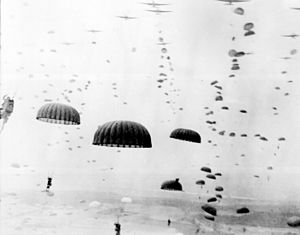| Operation Market Garden | |||||||||
|---|---|---|---|---|---|---|---|---|---|
| Part of the Allied advance from Paris to the Rhine on the Western Front during the Second World War | |||||||||
 Paratroopers of the First Allied Airborne Army descending over the Netherlands | |||||||||
| |||||||||
| Belligerents | |||||||||
|
| |||||||||
| Commanders and leaders | |||||||||
| |||||||||
| Units involved | |||||||||
|
|
| ||||||||
| Strength | |||||||||
| |||||||||
| Casualties and losses | |||||||||
|
15,326–17,200 killed, wounded, and captured 88 tanks destroyed[d] 377 aircraft and gliders lost[6][7] |
6,315–13,300 killed and wounded Unknown total captured | ||||||||

Operation Market Garden was an Allied military operation during the Second World War fought in the German-occupied Netherlands from 17 to 25 September 1944. Its objective was to create a 64 mi (103 km) salient into German territory with a bridgehead over the Nederrijn (Lower Rhine River), creating an Allied invasion route into northern Germany.[8] This was to be achieved by two sub-operations: seizing nine bridges with combined US and British airborne forces ("Market") followed by British land forces swiftly following over the bridges ("Garden").
The airborne operation was undertaken by the First Allied Airborne Army with the land operation by the British Second Army, with XXX Corps moving up the centre supported by VIII and IX Corps on their flanks. The airborne soldiers, consisting of paratroops and glider-borne troops numbering more than 41,000, were dropped at sites where they could capture key bridges and hold the terrain until the land forces arrived. The land forces consisted of ten armoured and motorised brigades with a similar number of soldiers. The land forces advanced from the south along a single road surrounded by flood plain on both sides. The plan anticipated that they would cover the 103 km (64 miles) from their start to the bridge across the Rhine in 48 hours. About 100,000 German soldiers were in the vicinity to oppose the allied offensive.[9] It was the largest airborne operation of the war up to that point.[e]
The operation succeeded in capturing the Dutch cities of Eindhoven and Nijmegen along with many towns, and a few V-2 rocket launching sites. It failed in its most important objective; securing the bridge over the Rhine at Arnhem. The Germans slowed and then halted the armoured brigades advancing from the south before they reached the Rhine. The British 1st Airborne Division was unable to secure the bridge and was withdrawn from the north side of the Rhine after suffering 8,000 dead, missing, and captured out of a complement of 12,000 men. When the retreat order came there were not enough boats to get everyone back across the river. The Germans subsequently rounded up most of those left behind, but some of the British and Polish paratroopers managed to avoid capture by the Germans and were sheltered by the Dutch underground until they could be rescued in Operation Pegasus on 22 October 1944.[11] Historians have been critical of the planning and execution of Operation Market Garden. Antony Beevor said that Market Garden "was a bad plan right from the start and right from the top".[12]
The Germans counter attacked the Nijmegen salient but failed to retake any of the allied gains. Arnhem was finally captured by the Allies in April 1945, towards the end of the war.
Cite error: There are <ref group=lower-alpha> tags or {{efn}} templates on this page, but the references will not show without a {{reflist|group=lower-alpha}} template or {{notelist}} template (see the help page).
- ^ Reynolds 2001, p. 173.
- ^ López, Todd (27 September 2019). "US, allies remember Market Garden". US Departement of Defense.
- ^ Antony Beevor, 2020, Order of Battle: Operation Market Garden. (Access: 15 March 2020.)
- ^ Reynolds 2001, pp. 100–101.
- ^ MacDonald 1963, p. 199, and endnotes.
- ^ MacDonald 1963, p. 199.
- ^ "Operation Market Garden Netherlands 17–25 September 1944" (PDF). gov.uk.
- ^ Wilmot 1997, p. 525.
- ^ The Battle for the Rhine 1944 by Robin Neillands, Chapter 4 The Road to Arnhem
- ^ MacDonald 1963, p. 132.
- ^ Kinloch, Nicholas (2023). From the Soviet Gulag to Arnhem: A Polish Paratrooper's Epic Wartime Journey. Pen and Sword. pp. 163–192. ISBN 978-1399045919.
- ^ Beevor 2018, p. 36.